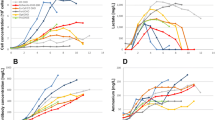Abstract
The effect of addition of peptone to serum-free and serum supplemented media for the growth of hybridoma cells in various systems was studied. Supplementation of defined medium with either proteose peptone or meat peptone resulted in significant increases in cell number and specific monoclonal antibody production in batch culture system. Other peptones were either inactive or less effective. In continuous culture, using medium supplemented with new born calf serum, the addition of peptone resulted in 125% and 150% increases in cell and antibody concentrations respectively. Similar increase in cell number (128%) was also obtained in spin-filter perfusion culture when medium was supplemented with peptone. By comparison, the substitution of a defined 1xMEM amino acids mixture resulted in only a 50% increase. At higher perfusion rates the cell number maintained in steady state using peptone supplement could be increased to 1.3×107 cells ml−1 while the serum concentration was reduced from 5% to 1% at a perfusion rate of 2.5 volumes per day.
Similar content being viewed by others
References
Al-Rubeai and Spier, RE (1988) ‘Hybridoma cultivation in serumsupplemented and serum-free media’, inAdvances in Animal Cell Biology and Technology for Bioprocesses, eds. RE Spier, JB Griffiths, J Stephenne, and PJ Crooy, Butterworth, London, pp. 277–279.
Al-Rubeai M, Emery AN, and Chalder S (1991) ‘Flow cytometric study of cultured mammalian cells’,J. of Biotechnology,Vol. 19, 67–82.
Dalili M, and Ollis DF (1989) ‘Transient Kinetics of hybridoma growth and monoclonal antiboody production in serum-limited cultures’,Biotechnology and Bioengineering,Vol. 33, 984–990.
Feder J, and Tolbert WR (1985) ‘Mass culture of mammalian cells in perfusion systems’,American Biotechnology Laboratory,Vol. 3, 24–36.
Glacken MW (1988) Catabolic control of mammalian cell culture,Bio/Technology,Vol. 6, 1041–1050.
Ghasegawa A, Yamashita H, Kondo S, Kiyota T, Hayashi H, Yoshizaki H, Murakami A, Shiratsuchi M, and Morei T (1988) ‘Proteose peptone enhances production of tissue-type plasminogen activator from human diploid fibroblasts’,Biochemical and Biophysical Research Communications,Vol. 150, 1230–1236.
Hild HM, Emery AN, Al-Rubeai M (1992) The effect of pH, temperature, serum concentration and media composition on the growth of insect cells, In: Workshop on baculovirus and recombinant protein production processes, Eds. Vlak JM, Schlaeger EJ, and Bernard AR, pp. 316–321 Editiones Roche, Basel.
Jan DC-H, (1992) Bioreactor design for intensification of mammalian cell culture, Ph. D. Thesis, University of Birmingham.
Jan DC-H, Emery AN, Al-Rubeai M (1992) Optimisation of spinfilter performance in the intensive culture of suspended cells. In Animal cell Technology: Developments, Processes & Products. Ed. R. E. Spier, J. B. Griffiths, C. MacDonald, Butterworth-Heinemann, Oxford, pp. 448–451.
Jan DC-H, AN Emery, M Al-Rubeai (1993) Introducing spin-filter eliminates hydrodynamic damage to hybridomas in bioreactor, Biotechnology Techniques, 7, 351–356.
Kea L (1976) ‘Autoclavable low cost serum-free cell culture media: the growth of established cell lines and production of viruses’,Biotechnology and Bioengineering,Vol. 18, 363–382.
Kea L (1977) ‘The growth of L-cells and vero cells on an autoclavable MEM-peptone medium’,Biotechnology and Bioengineering.Vol. 19, 399–411.
Luan YTR, Mutharasan WE, Magee (1987) ‘Strategies to extend longevity of hybridomas in culture and promote yield of monoclonal antibodies’,Biotechnology Letters,Vol. 9, 691–696.
Murakami H, Masui H, Sato GH, Sueoka N, Chow TP, and Kano-Sueoka T (1982) ‘Growth of Hubridoma Cells in Serum-Free Medium. Ethanolamine is an essential component’,proc. Natl. Acad. Sci. Vol. 79, 1158–1162.
Reuveny S, Velez D, Miller L, and Macmillan JD (1986) ‘Comparison of cell propagation methods for their effect on monoclonal antibody yield in fermenters’,Vol. 86, 61–69.
Rutzky LP (1981) ‘Peptone growth factors for serial proliferation in the absence of serum’, inThe Growth Requirements of vertebrate Cells in Vitro, edited by C Waymouth, RG Ham, and PJ Chapple, Cambridge University Press, London.
Tayler WG, Dwirkin RA, Pumper RW, and Evans VJ (1972) ‘Biological efficacy of several commercially available peptone for mammalian cells in culture’, Exptkl.Cell Res.,Vol. 74, 275–2799.
Taylor WG (1981) ‘Study on the chemical nature of a growthpromoting agent, Bacto-peptone Dialysate’,The Growth Requirements of Verrebrate Cells in Vitro, edited by C. Waymouth, R. G. Ham, and P. J. Chapple, Cambridge University Press, London.
Author information
Authors and Affiliations
Rights and permissions
About this article
Cite this article
Jan, D.CH., Jones, S.J., Emery, A.N. et al. Peptone, a low-cost growth-promoting nutrient for intensive animal cell culture. Cytotechnology 16, 17–26 (1994). https://doi.org/10.1007/BF00761775
Received:
Accepted:
Issue Date:
DOI: https://doi.org/10.1007/BF00761775




